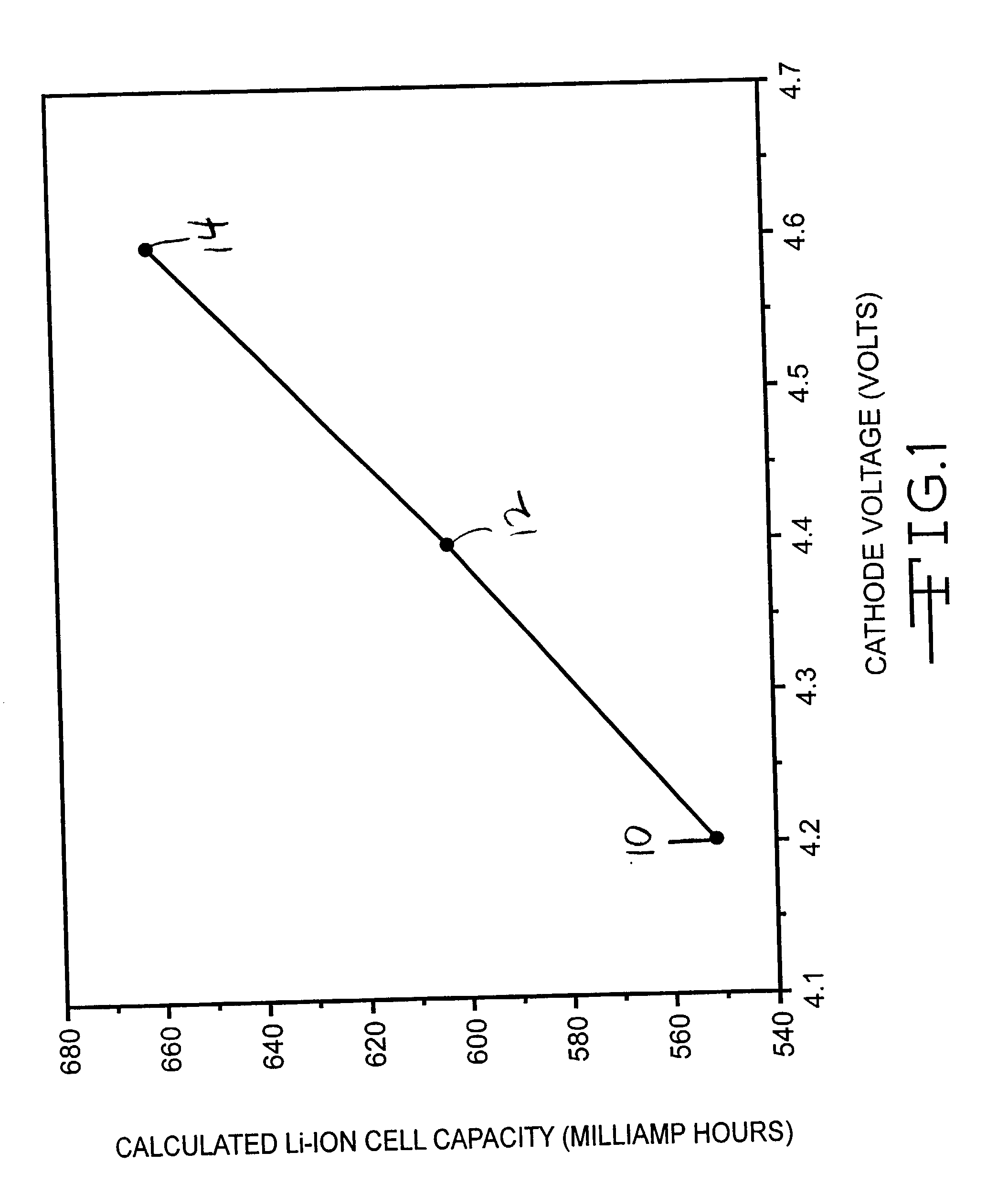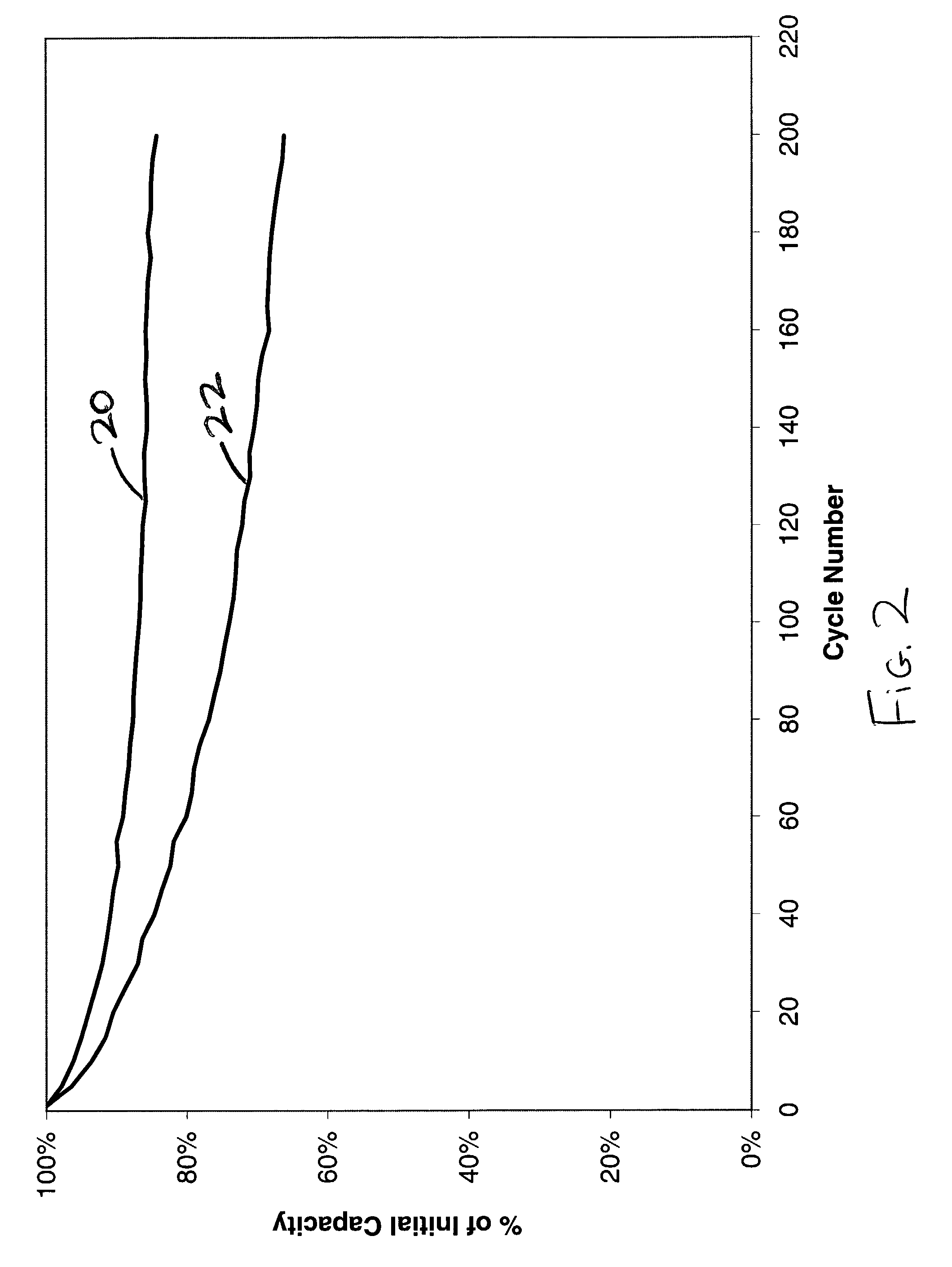High energy density rechargeable cell for medical device applications
a rechargeable cell and high energy density technology, applied in secondary cells, non-aqueous electrolyte cells, cell components, etc., can solve the problem of the energy density of the active material energy density of the lithium ion cell, and achieve the effect of increasing the energy density, and significantly more energy density
- Summary
- Abstract
- Description
- Claims
- Application Information
AI Technical Summary
Benefits of technology
Problems solved by technology
Method used
Image
Examples
example ii
Very Low Current Drain
[0029] Two Li / LiCoO.sub.2 coin cells were constructed in a similar manner as described in Example I. The cells were tested at very low current rates (C / 50), which is consistent with the discharge rate needed for certain medical device applications, such as a cardiac pacemaker in a device monitoring mode and an implantable hearing assist device. The results of this testing are listed in Table 2.
2TABLE 2 Li / LiCoO.sub.2 Coin Cell Testing at C / 50 Rate Cell Charge Voltage Cathode Discharge Capacity 4 4.55 V 219.2 mAh / g 5 4.54 V 219.3 mAh / g 4 4.60 V 251.1 mAh / g 5 4.60 V 240.8 mAh / g
[0030] The results shown in Table 2 indicate that the amount of capacity fade was decreased relative to that found at C / 5 in example I. In addition, the charge voltage needed to reach 80% of theoretical cathode capacity was found to decrease by 50 mV in this test. When the test cells were fully charged to 4.6 V, the cells delivered on average 90% of their total theoretical capacity. Thus, a...
example iii
Cell Balance of Present Invention
[0031] In order to utilize the increased capacity of LiCoO.sub.2 in a lithium ion cell for low rate applications, the cell balance, or the gram amount of cathode active material relative to the gram amount anode material, must be set to a proper ratio. A cell design based on the prior art usage of LiCoO.sub.2 in conjunction with a graphite anode typically requires a cell balance of about 2.3 (grams active cathode material / grams active anode material). According to the present invention, the appropriate cell balance is from about 1.7 to about 1.1, and preferably about 1.4. Thus, more anode material is required in the cell to store the additional lithium being supplied by the cathode. Without the additional anode material, reactive lithium metal would be deposited at the anode electrode during charging, creating an unsafe condition.
[0032] In that respect, a coin cell was constructed in a similar manner as described in Example I except that the anode ma...
example iv
Cell Balance And Capacity Fade
[0036] The importance of using the correct electrode material balance in a lithium ion cell is illustrated by this example. A lithium ion secondary coin cell was assembled in a similar manner as described in Example III. The reversible capacity for the graphite anode material was experimentally found to be about 340 mAh / g, with an additional 35 mAh / g of irreversible capacity during the first cycle. The reversible capacity of the LiCoO.sub.2 cathode was determined to be about 135 mAh / g. The cell was balanced such that the capacity of the lithium delivered by the cathode electrode would not exceed the reversible capacity of the anode material during charging of the cell. This cell was then charged and discharged at room temperature under a constant current using a C / 2 rate. The results of this cycling were used to construct curve 20 in FIG. 2.
[0037] A second coin cell was constructed using similar materials, but with about 14% extra cathode capacity. This...
PUM
 Login to View More
Login to View More Abstract
Description
Claims
Application Information
 Login to View More
Login to View More - R&D
- Intellectual Property
- Life Sciences
- Materials
- Tech Scout
- Unparalleled Data Quality
- Higher Quality Content
- 60% Fewer Hallucinations
Browse by: Latest US Patents, China's latest patents, Technical Efficacy Thesaurus, Application Domain, Technology Topic, Popular Technical Reports.
© 2025 PatSnap. All rights reserved.Legal|Privacy policy|Modern Slavery Act Transparency Statement|Sitemap|About US| Contact US: help@patsnap.com


